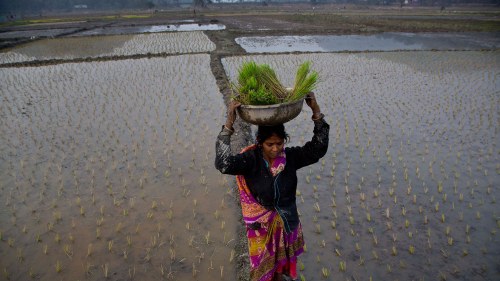Are Global Food and Water Demands on a Collision Course?

The world is facing three global water crises—it's imperative that we respond to them.
Water is the bedrock of the food system on our planet. But the increasingly unstable balance between food and water security has been on vivid display this summer. Drought, fire, and flooding are painful sudden shocks to a food system that depends so directly on reliable rain. As climate change permanently reshuffles rainfall patterns away from the 80 percent of cultivated land that depends on regular rainfall, our food and water demands are on a collision course.
October 16 is 2023’s World Food Day, and the theme is “Water is life, water is food. Leave no one behind.” The urgency in these statements is apt. Nearly 2.2 billion people do not have access to safely managed water. And after a decade of decreases, rates of global hunger have more than doubled since 2020. The World Food Programme estimates that, even though we produce far more food than is necessary to feed the population, at least 345 million people are highly food insecure.
The irony is that the increasing stress put on our water is, in part, a direct reflection of the success we’ve had in bringing people out of extreme poverty and into greater agricultural productivity. As people rise out of poverty, they demand more water intensive goods, foods, and more reliable water access. Agriculture has become increasingly productive and more efficient. This is a good thing, but it puts new stresses on an already stressed system and we’ve done little to prepare for this growth. The rate of per capita water use has risen steadily over the last century, much faster than population growth. Despite agriculture’s enormous gains in productivity, its scale has become extremely water and carbon intensive.
There are at least three distinct “global water crises” that result from this. And we’re dealing with them simultaneously.
Crisis of Supply
The first is a crisis of supply. The idea that we’re “running out” of water is misguided. The amount of water on the earth doesn’t really change much. But the form that it takes (salinated or fresh, polluted or clean) does. It requires fuel, energy, and human effort, time, and infrastructure investment, to convert water from one form to another, or to move it to where it’s needed. Water availability is geographic in that water has to be where we want it, when we want it, in the form that we want it, to be useful for food production.
This has consequences for farming at all scales. High-production, irrigated farmland depends overwhelmingly on groundwater aquifers that are being depleted much faster than they can be replenished. While only 20 percent of agricultural land is irrigated, that land produces 40 percent of the world’s food. Further intensifying food production via irrigation implies increased demand for non-renewable groundwater and chemical fertilizer produced by fossil fuels. Meanwhile, climate change is shifting weather patterns in ways that make rainfed agriculture extremely vulnerable. Food production is threatened in both cases.
Crisis of Public Health
The second crisis is one of public health. The 2.2 billion people who don’t have safe water must drink unsafe water. There’s no alternative for them. As a result, the global disease burden associated with poor water quality continues to be very high. More than 360,000 children below the age of five die every year from causes linked to contaminated water contact. Usually the cause is diarrheal disease, which would be easily avoided if there were safe water available to rehydrate them. Women and girls tend to suffer the most under conditions of low water security. Collectively they spend an estimated 220 million hours a day collecting water. This is time that could be used for other things—going to school, for instance, which we know dramatically raises a woman’s lifetime income, allows her to avoid early marriage, and repeated childbearing.
This is a solvable crisis. Every dollar invested in water for sanitation and hygiene provides an estimated $4.3 return in lower morbidity, and higher (especially female) productivity. There’s about an $114 billion dollar annual gap in water sanitation financing globally. It’s within reach if we really are committed to “leaving no one behind.”
Crisis of Development
The third water crisis is related to development. The basic form of this problem is what we call the food-water-energy nexus. Increased food production requires more intense water use, which in turn requires more energy production. More energy production requires more water use. If we’re able to grow ourselves out of global poverty, this nexus is more difficult because water, arable land, and fossil energy have a fixed supply.
We can stretch things out with efficiency gains in any of these areas, but ultimately there’s a limit. And we don’t yet have a vision for what alternatives will be. Our current renewable energy directions don’t fix this, because photovoltaics and biofuels are extremely water intensive. Increasing food production efficiency on existing land, meanwhile, requires a lot of chemical fertilizer—created with fossil fuels and responsible for a large portion of agriculture’s carbon footprint.
There’s a sense in which all this puts the Sustainable Development Goal targets for food and water security in conflict with one another. How can we satisfy increased demand for food on a system threatened by disrupted production and shifting patterns of water availability? How can we ensure food security without continuing to burn through finite resources to do it? These are difficult and urgent questions.
World Food Day’s focus is well placed, and critically timed. “Water is life, water is food. Leave no one behind” is a call to action. We desperately need to respond to it.

